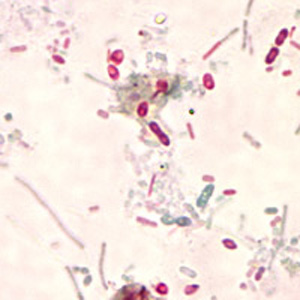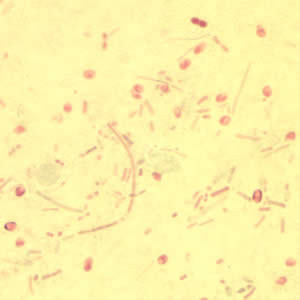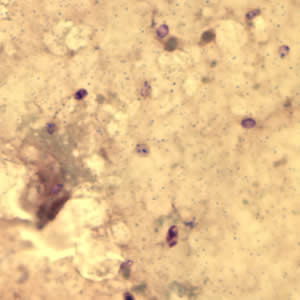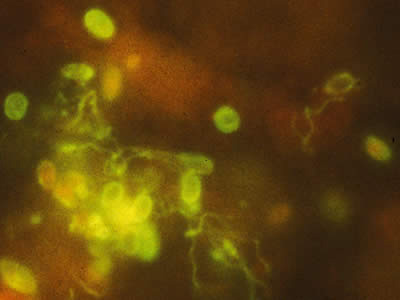Microsporidiosis laboratory findings: Difference between revisions
Jump to navigation
Jump to search
Ahmed Younes (talk | contribs) No edit summary |
Ahmed Younes (talk | contribs) |
||
| Line 22: | Line 22: | ||
===Serologic assays:=== | ===Serologic assays:=== | ||
*IgM or IgG anti microsporidial antibodies can be detected in serum using indirect immunofluorescence assays. | *IgM or IgG anti microsporidial antibodies can be detected in serum using indirect immunofluorescence assays. | ||
{| class="wikitable" | |||
![[Image:Ehellem spores IFA 2012.jpg|center|300px|thumb|Ehellem spores IFA 2012]] | |||
|} | |||
===PCR=== | ===PCR=== | ||
*Molecular identification of Enterocytozoon bieneusi, Encephalitozoon intestinalis, Encephalitozoon hellem and Encephalitozoon cuniculi using PCR is available. | *Molecular identification of Enterocytozoon bieneusi, Encephalitozoon intestinalis, Encephalitozoon hellem and Encephalitozoon cuniculi using PCR is available. | ||
Revision as of 16:24, 30 June 2017
|
Microsporidiosis Microchapters |
|
Diagnosis |
|---|
|
Treatment |
|
Case Studies |
|
Microsporidiosis laboratory findings On the Web |
|
American Roentgen Ray Society Images of Microsporidiosis laboratory findings |
|
Risk calculators and risk factors for Microsporidiosis laboratory findings |
Editor-In-Chief: C. Michael Gibson, M.S., M.D. [1];Associate Editor(s)-in-Chief: Ahmed Younes M.B.B.CH [2]
Overview
Laboratory findings consistent with the diagnosis of microsporidiosis include microscopic identification of the organism in fecal smears, positive PCR, and positive serology.
Lab findings
Microscopic identification of the organism
- Identification of the organism in the stool specimens is a quick and cheap method for diagnosis.
- Special stains must be used because spores are not visible with ordinary stains.
- Using chromotrope 2R method, spores appear pink with belt like stripes in the middle of the spores.
- Chromotrope 2R staining technique takes about 90 minutes.
- Using Quick hot gram chromotrope, organism appears dark violet and the belt-like stripes are enhanced.
- Quick hot gram provides better visualization of the organism and cuts down the time needed for staining to 10 minutes.
- Enterocytozoon bieneusi spores measure 0.8 - 1.4 mcm while Anncaliia algerae, Encephalitozoon spp., Vittaforma corneae, and Nosema spp spores measure 1.5 - 4 mcm.
- Fecal smears shows no WBCs nor blood unless concamitant infection is present.
 |
 |
 |
|---|
Serologic assays:
- IgM or IgG anti microsporidial antibodies can be detected in serum using indirect immunofluorescence assays.
 |
|---|
PCR
- Molecular identification of Enterocytozoon bieneusi, Encephalitozoon intestinalis, Encephalitozoon hellem and Encephalitozoon cuniculi using PCR is available.
- PCR is the most sensitive and specific method for diagnosing microsporidiosis yet it is expensive and not recommended for routine diagnosis.